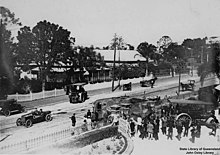Capture and transport to Australia

The tank was lost at the Second Battle of Villers-Bretonneux on 24 April 1918. The battle for the area saw the Australian, British, and German forces in a fluid situation, moving around the tank, which had been abandoned after falling into a ditch.
The 26th Battalion of the 7th Brigade, mostly from Queensland,[3] hatched a plan to capture it. In July 1918, under the cover of an artillery barrage, Australian infantry and two British vehicles (either Gun Carriers or Mark IV tanks) moved forward and dragged it back to their lines under fire from the Germans who were still within sight of the tank. They had to don gas masks after German poison gas was deployed.
The 26th Battalion working party involved in the recovery of Mephisto on 22 July 1918 probably consisted of Sergeant F.R. Hanson, Privates J. Battley, G. Bradley,T. Clark, H.J. Dray, E.J. Frost, A.W. Heit, J.J. Kennedy, T.M. Kingston, R.J. Lewis, A.G. Masters, W. Sam, and G.H. White.[4]

Following its capture, Mephisto was transported to the 5th Tank Brigade demonstration ground at Vaux-en-Amiénois near Amiens. During its stay there it was decorated with "soldier-art" paintings of a British lion with its paw on an A7V, many soldiers' names, details of its capture and recovery, the colour patch of the 26th Battalion and the rising sun badge of the Australian Imperial Force (A.I.F.) The words "TANK BOYS" and the names of 13 soldiers (mainly from other Australian units) were engraved on the front, left side, and rear armour. From Vaux-en-Amiénois, Mephisto was shipped by rail to the Tank Corps Gunnery School at Merlimont and then shipped from Dunkirk to London. Proposals for it to be displayed as a war trophy in Australia were raised, and on 2 April 1919 it was loaded on the SS Armagh at Tilbury. The ship was to deliver it to Sydney, with plans for it to go to the war memorial in Canberra's display, but it was diverted to Brisbane, arriving on 6 June 1919 at the Norman Wharf (near the intersection of Creek Street and Eagle Street, approximately where the Eagle Street Pier ferry wharf is today) in the Brisbane River.[5] On 22 August 1919 two steamrollers from the Brisbane Municipal Council pulled Mephisto (travelling on its own caterpillar treads) from the wharf to the Queensland Museum (then at the Old Museum building in Bowen Hills), a journey of less than 2 miles taking 11 hours.[6][7]
No comments:
Post a Comment